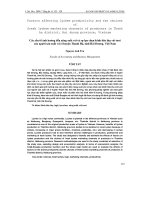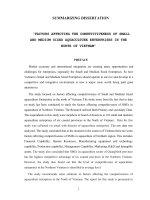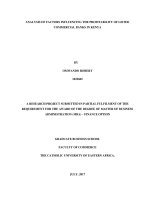379 factors affecting the profitability of commercial banks in vietnam from 2009 2018 bachelor thesis of banking and finance 2023
Bạn đang xem bản rút gọn của tài liệu. Xem và tải ngay bản đầy đủ của tài liệu tại đây (837.64 KB, 137 trang )
MINISTRYOFEDUCATIONANDTRAINING
STATEBANKOFVIETNAM
BANKINGUNIVERSITYHOCHIMINHCITY
NGUYENTHIMINHTHU
FACTORS AFFECTING THE PROFITABILITY
OFCOMMERCIALBANKSINVIETNAM
FROM 2009– 2018
GRADUATE
THESISMAJOR:FINANCEBANKING
CODE:52340201
SUPERVISORMSC.
VUTHIHAIMINH
HOCHIMINHCITY,2020
MINISTRYOFEDUCATIONANDTRAINING
STATEBANKOFVIETNAM
BANKINGUNIVERSITYHOCHIMINHCITY
NGUYENTHIMINHTHU
FACTORS AFFECTING THE PROFITABILITY
OFCOMMERCIALBANKSINVIETNAM
FROM 2009– 2018
GRADUATE
THESISMAJOR:FINANCEBANKING
CODE:52340201
SUPERVISORMSC.
VUTHIHAIMINH
HOCHIMINHCITY,2020
1
ABSTRACT
The purpose of this thesis is to provide an analysis of factors affecting
theprofitability of 28 commercial banks in Vietnam from 2009 to 2018 using PooledOLS,
FEM, REM, FGLS methods. The scope of the study is to aim at finding andanalyzing the
degree
ofimpactofs p e c i f i c
bankfactors,
industry-specific
f a c t o r s andmacroeconomicfactorsontheprofitabilityof28commercialbanksi n Vietnam. The study cannot
avoid the limitations because of the selection may notfully reflect the content and the
meaning of all factors affect profitability or may notfullyrepresent all commercial banksin
Vietnam.
Understanding the factors influencing the performance of the bank not onlyreceives
much attention from scholars, but also from shareholders, administratorsand authorities,
because it assists policy makers and administrators in formulatingstrategies and policies
to ensure the stability and sustainability of banking system'soperation, as well as to
avoidthe
risk
of
banking
system
crisis.
Assessing
theprofitabilityofacommercialbankalwaysraisesquestions,becauseoftheirdiversity.
Many
researchers consider that profitability can provide a picture of thebank'sbusinessresults.
Obtained result showed that ROA of commercial banks in Vietnam wasaffected
positively and statistically significant by bank size, equity ratio, loan ratio,deposit ratio,
income diversification ratio, credit growth rate and GDP; while non-performing loan,
operating cost and exchange rate have negative impact on ROA. Incontrast,liquidity,credittoGDPand
inflationdonotaffectROAandarenotstatistically significant.
Keywords:commercialbanks,profitability,ROA,banksize,nonperformingloan,equityratio,liquidityratio,loanratio,depositratio,incomediversificationratio
,operatingcost,credittoGDP,creditgrowthrate,GDP,inflation,exchange rate.
SUMMARY
International
economic
integration
is
an
indispensable
trend
and
an
objectiverequirementforanycountryinthecurrentdevelopmentstage.However,thisprocess,
in
addition
to
creating
certain
advantages
and
opportunities
for
the
countryparticipatingintheintegration,alsoputthesecountriesbefores i g n i f i c a n t difficulties
andchallenges.Theroadmapofinternationaleconomicintegrationputsenterprises of developing countries in general,
the commercial banking system inparticular and the new business environment with
fierce competitionpressures,unbalanced competitors. Currently, Vietnam is a member of
the
United
Nations,
theWorldTradeOrganization,theInternationalMonetaryFund,theWorldBankGroup,
the
Asian Development Bank and the Joint Forum Economic CooperationAsia-Pacific,
ASEAN. Vietnam participates in multilateral free trade agreementswith ASEAN
countries, South Korea, Japan and China. Vietnam has also signedwith Japan a bilateral
economic
partnership
agreement.
For
banking
and
monetarysystem,theintegrationprocessisassociatedwiththeprocessofl i b e r a l i z i n g fina
ncial market, bringing many opportunities, but also many challenges. From thatpractice,
this
thesis
will
analyze
and
introduce
factors
affecting
the
efficiency
in
theoperationofVietnam’scommercialbankingsysteminthecurrenti n t e g r a t i o n period,
especially the factors affecting the profitability of commercial banks inVietnam, from
which
to
give
practical
recommendations
to
improve
the
operationalefficiencyofcommercialbanking system,is anurgent issue.
Thisthesisanalysesfactorsaffectingtheprofitabilityof28c o m m e r c i a l banks
Vietnam
from
2009
to
2018
using
regression
methods
such
as
in
Pooled
OLS,FEM,REM,FGLS;therebyprovidesomerecommendationstoimprovetheprofitabilityof
commercial banksin Vietnam.
In order to further analyze the impact of Vietnam's macro environment andbanking
industry
on
the
profitability
of
Vietnamese
commercial
banks,
the
authordecidedtoconsiderthreemoreindependentvariables,namelyexchangerate,credit
toG D P a n d c r e d i t g r o w t h r a t e a l o n g w i t h t w o f a m i l i a r m a c r o f a c t o r s w h i c
h a r e inflationandGDPgrowth.
Thet a b l e b e l o w s u m m a r i z e s r e l a t e d p r e v i o u s s t u d i e s a n d t h e o r
e t i c a l frameworkof thisthesis.
Table0.0.1:Relatedpreviousstudiesandtheoreticalframework
Theory/Related
previousstudies
Commercialbanks
Subjectsarementioned
Definitionofcommercialb
anks
Definition of
bankprofitability
Profitability
Measurement
Marketpowertheory
Efficiencytheory
Agencycosttheory
It explains the profit
offirms to be increased
fromtheachievement
ofmore
marketpower
It explains other aspect
ofbankprofitabilitywhichcan be
generated
frombettermanagement
and
businessefficiency
This theory focuses on
theuseoffinancing
Previous studies
andrelatedlaw, decree
- Law:
Consolidateddocument
sNo.
20/2018/VBHN-NHNN,
theStateBankofVietnam
- Previous studies: Getter,
(2016), Tariq et al.
(2014),Tuyishimeetal.
(2015),Kalpana&
Rao(2017),
Mongid et al.
(2012),Erina&Lace
(2013)
Wang & Wang
(2015),Bikker & Vervliet
(2017),Iacobelli(2017),Yuk
selet al. (2018), Muya
&Gathogo (2016), Niresh
&Velnampy(2014),Sehrish,
Irshad &
Khalid(2010),Pastory &
Marobhe(2015),Kohler
(2013)
Book:Principalsof
finance, Scott, B.
&Eugene,F.B.(2015)
Bain(1951)
Demsetz(1973)
Jensen&Meckling
structure
of the firms to drive
themanagersand the
investors to solve
freecashflowissues
This theory
emphasizesthatthefirms
withprofitable condition
Arrow (1972) and
andhigh
Spence(1973)
businessperformance can
supplythemarketand the
customers with
positiveinformation
Almaqtari et al. (2018), Yao et al. (2018), Yuksel et al.
(2018),Kawshala&Panditharathna(2017),Nuhiuetal. (2017), Pastory &
Marobhe (2015), Sehrish Gul,Faiza Irshad and Khalid
Zaman (2011), Abuzar (2013),Usman,D.(2014),Khaled,M.et.al
(2016),Sufian,F.&Noor-Mohamad-Noor,A.(2012),AlOmar,H.&
Al-Mutairi,A.(2008)
Nguyen (2018), Nguyen et al. (2018), Le et al.
(2017),Nguyen,D.(2017),Phan&Phan(2014),Vo&
Batten(2014),Vu&Nahm(2013), NguyenThanhPhong
(2015),PhanThiHangNga(2011)
Source:Author’ssynthesis
Signalingtheory
Foreignstudies
Nationalstudies
Theresearchmodelproposedspecificallyasfollows:
ROAit= 𝛽 O+𝛽 1SIZEit+𝛽 2NPLit+𝛽 3LIQit+𝛽 4EQRit+𝛽 5LOANit
+𝛽 6DEPit+𝛽 7IDRit+𝛽 8OPRit+𝛽 9CRDt+𝛽 1OCGRt
+𝛽 11GDPt+𝛽 12INFt+𝛽13ERt+µi
Where:βo: constant termo: constant term
βo: constant term1, ..., βo: constant term14: Regression coefficients for the independent
variablesi:bank;t:year of observation;μi: errorterm/ residualterm
Dependentvariables:
ROA:return on assets (%)
Independentvariables(bank-specificfactors):
SIZE:
bank
VND)NPL:
size
(billion
non-performing
(%)LIQ:liquidity ratio(%)
loan
EQR: equity ratio
(%)LOAN: loan ratio
(%)DEP:depositsratio(%)
IDR: income diversification ratio
(%)OPR:operating costratio(%)
Independentvariables(industry-specificfactors):
CRD: credit to
GDPCGR:creditgrowthrat
e
Independentvariables(macro-economicspecificfactors):
INF:inflation
GDP:grossdomestic product
ER:exchangeratebetweenVNDandUSD
The thesis performs: (1) Descriptive statistics; (2) Correlation analysis; (3)Model
estimation (Pooled OLS, FEM, REM); (4) Model choice (Between PooledOLS and FEM,
between FEM and REM); (5) Model diagnostics (Autocorrelationdiagnostics,
multicollinearity
diagnostics,
heteroskedasticity
diagnostics);
(6)
Modelfix;(7)
Thepredictionof residuals; (8) Normalitytest of residuals.
The result of model choice analysis showed that both FEM and REM
weremoreappropriatethanPooledOLS.Furthermore,FEMwasprovenasmoreappropriatethan
REM.However,theauthoridentifiedthatt h e r e w a s autocorrelation issue in the dataset.
The result of heteroskedasticity check revealedthat FEM model did face up with this
issue. To fix the model problems, the authorconductedFGLS regressiontechnique andhere
is the result:
ROAit=O.2977677+O.O512939SIZEit−O.O578244NPLit
+O.OO76355EQR it+ O.OOO3152LOAN it+O.O233O87DEP it
+O. 167O282IDR it− O.OO38O13OPR it+ O.O1O235CGR t
+O.OO96277GDP t−O.O31288ER t
However, while some independent variables are in line with the expectationsof the
author,
there
are
some
independent
variables
that
contrary
to
the
author'sinitialexpectations.Detailed isshown asbelow:
Table0.0.2:Expectationsandresearchresultsofindependentvariables
Code
SIZE
NPL
LIQ
EQR
LOAN
DEP
IDR
OPR
CRD
CGR
GDP
INF
ER
Expected
Results
signs
Banksize
+
+
Non-performingloan
Liquidityratio
Noimpact
Equityratio
+
+
Loanratio
+
+
Depositratio
+
+
Incomediversificationratio
+
+
Operatingcostratio
Creditto GDP
+
Noimpact
Creditgrowth rate
+
+
Grossdomesticproductgrowth
+
+
Inflation rate
Noimpact
ExchangeratebetweenVNDandUSD
(Source:Author’ssynthesis)
Description
Based on the research results, the author will provide some recommendationsinchapter
5 to improve commercial banks’ profitability, thereby helping policymakersto easily controland optimize
theprofitability of commercialbanks.
DECLARATION
I hereby declare that the graduate thesis is my original work, written by meunder
the guidance of Ms. Vu Thi Hai Minh and it has not been presented forexamination in
anywhere else. The data and sources cited in the thesis have beenduly acknowledged.
Itake full responsibilityfor my pledge.
Author
NguyenThiMinhThu
ACKNOWLEDGEMENT
Itismyradiantsentimenttoplaceonrecordmybestregards,deepestsenseof gratitude
tomysupervisoratBankingUniversityinHoChiMinhCity-Ms.VuThi Hai Minh, for her patience, motivation,
enthusiasm, and immense knowledge.She has wholeheartedly helped and guided me in
the process of writing this thesis. Ichoosethismomenttoacknowledgehercontributionasshehasbeensupportiveofmy
study and has actively provided me with enormous information to achieve thegoal.
Also,Iwouldliketothankallofmyfriends, whoalwayssupport andhelpmethro
ughthe study together withthe inspiration they gaveme.
Author
NguyenThiMinhThu
ABBREVIATIONLIST
Abbreviation
Meaning
FEM
Fixedeffectmodel
FGLS
FeasibleGeneralizedLeastSquares
GDP
Grossdomesticproduct
INF
Inflation
MARG
NIM
NOVX
PooledOLS
Netfinancing margin
NetInterestMargin
Non-interestexpensestoaverage totalassets
PooledOrdinaryLeastSquares
REM
Randomeffect model
ROA
Returnonasset
ROCE
Returnon capitalemployed
ROE
Std.Dev.
VIF
Returnon equity
StandardDeviation
VarianceInflationFactors
LIST OFTABLES
Table0.0.1:Related previousstudiesandtheoreticalframework...................................iii
Table0.0.2:Expectationsandresearch resultsof independentvariables........................vi
Table2.1:Summaryofstudiesontheimpactoffactorsaffectingbankprofitability
...................................................................................................................................22
Table2.2: Limitation of empirical research..............................................................25
Table3.1: Summary of debt groups..........................................................................34
Table3.2: Variablesused in the model......................................................................39
Table4.1: Descriptive statistics................................................................................46
Table4.2: Pearson correlation..................................................................................49
Table4.3: PooledOLS output....................................................................................50
Table4.4: FEM output..............................................................................................52
Table4.5: REM output.............................................................................................54
Table4.6: ModelchoicebetweenPooledOLS and FEM..............................................56
Table4.7: ModelchoicebetweenFEM and REM.......................................................56
Table4.8: Autocorrelation diagnostics.....................................................................57
Table4.9: Multicollinearity diagnostics....................................................................57
Table4.10:Heteroskedasticity diagnostics.................................................................58
Table4.11:Cross-sectionaltime-seriesFGLSregression.............................................58
Table4.12:Thepredictionof residuals........................................................................59
Table4.13:Normality testof residuals.......................................................................60
Table0.1: List of commercial banksselected fortheresearch................................xxxiii
LIST OFFIGURES
Figure3.1:Research process......................................................................................31
Figure3.2:ROAtrendsof Vietnamesecommercial banksduring2009-2018................33
LIST OFPICTURES
Picture1:Descriptivestatistics..................................................................................xlv
Picture2:Correlation analysis.................................................................................xlvi
Picture3:PooledOLSoutput...................................................................................xlvii
Picture4:FEMoutput............................................................................................xlviii
Picture5:REMoutput..............................................................................................xlix
Picture6:ModelchoicebetweenPooledOLSandFEM...............................................xlix
Picture7:ModelchoicebetweenFEMandREM..............................................................l
Picture8:Autocorrelationdiagnostics..........................................................................li
Picture9:Collinearitydiagnostics................................................................................li
Picture10:Heteroskedasticitydiagnostics...................................................................lii
Picture11:FGLSoutput..............................................................................................lii
Picture12:Thepredictionofresiduals..........................................................................lii
Picture13:Normalitytestofresiduals...........................................................................lii
TABLEOFCONTENTS
ABSTRACT............................................................................................................... i
SUMMARY..............................................................................................................ii
DECLARATION....................................................................................................vii
ACKNOWLEDGEMENT.....................................................................................viii
ABBREVIATIONLIST............................................................................................ix
LIST OF TABLES....................................................................................................x
LISTOF FIGURES....................................................................................................x
LISTOF PICTURES.................................................................................................xi
TABLE OF CONTENTS........................................................................................xii
CHAPTER1: INTRODUCTION...............................................................................1
1.1. Backgroundof thestudy....................................................................................1
1.2. Objectivesof the study.....................................................................................2
1.2.1. Generalobjectives......................................................................................2
1.2.2. Specificobjectives.....................................................................................2
1.3. Researchquestions...........................................................................................2
1.4. Subjectand scope of the study..........................................................................2
1.4.1. Subjectof the study....................................................................................2
1.4.2. Scopeof the study......................................................................................2
1.5. Researchmethodology.....................................................................................3
1.6. Significanceof thestudy...................................................................................3
1.6.1. Scientificsignificance................................................................................3
1.6.2. Practicalsignificance..................................................................................3
1.7. Structureof the study........................................................................................4
CHAPTER2: THEORETICAL BASISANDLITERATURE REVIEW.....................5
2.1. Theoreticalbasis about commercial bank.........................................................5
2.2. Theoreticalbasis about commercial bank profitability.....................................6
2.2.1. Definitionof bankprofitability...................................................................6
2.2.2. Theindicators reflect the profitability ofcommercialbanks.........................7
2.2.2.1. ReturnonAssets-ROA.........................................................................8
2.2.2.2. ReturnonEquity -ROE.........................................................................9
2.2.2.3. NetInterest Margin-NIM.....................................................................9
2.2.3. Factorsaffecting commercial bankprofitability........................................10
2.2.3.1. Internalfactors...................................................................................10
2.2.3.2. Externalfactors..................................................................................10
2.3. Theoreticalframework...................................................................................10
2.3.1. Marketpower theory................................................................................11
2.3.2. Efficiencytheory......................................................................................11
2.3.3. Agency cost theory.................................................................................12
2.3.4. Signalingtheory.......................................................................................12
2.4. Literaturereview............................................................................................13
2.4.1. Foreignstudies.........................................................................................13
2.4.2. Nationalstudies........................................................................................18
2.4.3. Previousstudies’gap and summary..........................................................22
2.4.3.1. Previousstudies’ gap.........................................................................22
2.4.3.2. Summary..........................................................................................28
CONCLUSIONOF CHAPTER2.............................................................................29
CHAPTER3: METHODOLOGY............................................................................30
3.1. Datacollection...............................................................................................30
3.2. Researchprocess............................................................................................30
3.3. Researchmodel..............................................................................................32
3.3.1. Dependentvariables.................................................................................32
3.3.2. ROAtrendsofVietnamese commercial banksduring2009-2018................32
3.3.3. Independentvariable................................................................................33
3.3.3.1. Bank size (SIZE)..............................................................................34
3.3.3.2. Non-performing loan ratio (NPL).....................................................34
3.3.3.3. Liquidity ratio(LIQ)..........................................................................34
3.3.3.4. Equity ratio (EQR)............................................................................35
3.3.3.5. Loanratio (LOAN)............................................................................35
3.3.3.6. Depositratio (DEP)...........................................................................36
3.3.3.7. Incomediversification ratio (IDR).....................................................36
3.3.3.8. Operatingcostratio (OPR).................................................................36
3.3.3.9. Creditto GDPratio (CRD).................................................................37
3.3.3.10. Creditgrowth rate(CGR)..................................................................37
3.3.3.11. AnnualGDPgrowth rate (GDP).......................................................37
3.3.3.12. Inflation rate(INF)..........................................................................38
3.3.3.13. Foreignexchange rate (ER).............................................................38
3.3.4. Summarize..............................................................................................38
3.3.5. Proposedresearch modelandhypotheses...................................................41
3.4. Researchmethods...........................................................................................42
3.4.1. Pooledordinaryleast square(Pooled OLS)................................................43
3.4.2. Fixedeffectmodel(FEM)..........................................................................43
3.4.3. Randomeffectmodel(REM).....................................................................44
3.4.4. FGLS(FeasibleGeneralizedLeast Squares)..............................................45
CONCLUSIONOF CHAPTER3.............................................................................45
CHAPTER4: RESULTSAND FINDING................................................................46
4.1. DescriptiveStatistics......................................................................................46
4.2. Correlationanalysis........................................................................................48
4.3. Modelestimation............................................................................................50
4.3.1. Pooledordinaryleast square(PooledOLS).................................................50
4.3.2. Fixedeffectmodel(FEM)..........................................................................52
4.3.3. Randomeffectmodel(REM).....................................................................54
4.4. Modelchoice..................................................................................................55
4.4.1. BetweenPooledOLS and FEM................................................................55
4.4.2. BetweenFEM andREM...........................................................................56
4.5. Modeldiagnostics...........................................................................................56
4.5.1. Autocorrelationdiagnostics......................................................................57
4.5.2. Multicollinearitydiagnostics....................................................................57
4.5.3. Heteroskedasticitydiagnostics.................................................................58
4.6. Modelfix........................................................................................................58
4.7. Thepredictionof residuals...............................................................................59
4.8. Normalitytestof residuals...............................................................................59
4.9. Discussthe research results............................................................................60
4.9.1. Banksize (SIZE)......................................................................................60
4.9.2. Non-performingloan (NPL).....................................................................61
4.9.3. Liquidity ratio(LIQ)................................................................................61
4.9.4. Equity ratio(EQR)...................................................................................62
4.9.5. Loanratio (LOAN)...................................................................................62
4.9.6. Depositratio (DEP)..................................................................................63
4.9.7. Incomediversification ratio(IDR)............................................................63
4.9.8. Operating costratio(OPR)........................................................................64
4.9.9. Creditto GDP (CRD)...............................................................................64
4.9.10. Creditgrowth rate (CGR).......................................................................65
4.9.11. Grossdomestic product GDP)................................................................65
4.9.12. Inflationrate(INF)..................................................................................66
4.9.13. Exchangerate (ER)................................................................................66
CONCLUSIONOF CHAPTER4.............................................................................67
CHAPTER5: CONCLUSION ANDRECOMMENDATION..................................68
5.1. Conclusion....................................................................................................68
5.2. Recommendation...........................................................................................69
5.2.1. Banksize (SIZE)......................................................................................69
5.2.2. Non-performingloan (NPL).....................................................................70
5.2.3. Equity ratio (EQR)..................................................................................71
5.2.4. Loanratio (LOAN)...................................................................................72
5.2.5. Depositratio (DEP)..................................................................................73
5.2.6. Incomediversification ratio (IDR)...........................................................74
5.2.7. Operatingcostratio(OPR).........................................................................75
5.2.8. Creditgrowth rate (CGR).........................................................................76
5.2.9. Grossdomestic product(GDP)..................................................................76
5.2.10. Exchangerate (ER)................................................................................77
5.3. Limitationof the study...................................................................................78
5.4. Futureresearch directions...............................................................................78
CONCLUSIONOF CHAPTER5.............................................................................79
REFERENCES.....................................................................................................xviii
APPENDIX........................................................................................................xxxiii









